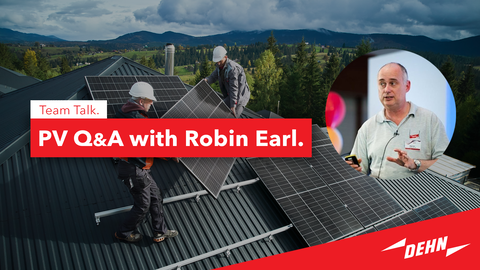With the UK experiencing one of its sunniest years on record, DEHN are using July as an opportunity to dive deeper into the world of PV and solar technology.

This rapidly growing industry shows no signs of slowing down - the UK government aims to reach 70 GW of solar power by 2035, and by 2030, the sector could support around 35,000 jobs - double the current figure!
A surge (no pun intended) in PV adoption has come with an equally significant need for robust safety and protection measures - that’s where we come in. To explore how to safeguard your solar installations, we spoke with our Marketing Development Manager, Robin Earl, about how DEHN UK is uniquely positioned to lead the way.
What role does DEHN play in ensuring the longevity and reliability of PV systems?
The earlier DEHN is involved on a PV project, the better off a client is from a cost perspective, ensuring no nasty surprises later down the line, or even when the project is handed over. We are equipped to assist with risk assessments and designs, and can provide a detailed layout of Surge Protection Device (SPD) requirements. SPDs are often treated as an afterthought, and when retrofitted, they rarely offer the same level of integration when compared to solutions that are incorporated into the design from the outset.
What are the most common electrical risks you see in PV installations?
We often see AC SPDs in DC circuits. The SPD for PV installations on the DC side must be specialised to ensure that there is no risk of DC arcing and fire at the end of an SPDs life. This is why DC PV SPDs must meet BS EN 61643-31 regulation, as the internal construction is different - just as DC rotary isolators are different from AC. The SPD must also have a rapid arc quenching feature - an aspect that is different from AC SPDs.
In your experience, what are the most overlooked aspects of lightning protection when it comes to PV?
The omission of type 1 DC PV SPDs on bonded roof mounted installations to the lightning protection - it’s a mistake to assume that the SPD built into an invertor is suitable for lightning type 1 currents. Also, the omission of a data line SPD in the larger ground mount systems. Too many sites are at risk of surges to their RS485 comms links, damaging combiner boxes and monitoring equipment. Other types of data links are at risk as well.
What advice would you give to engineers or consultants regarding PV system protection?
As I mentioned in the answer to the first question, involve a specialist - like DEHN - to assist as early as possible. DEHN UK are the knowledge hub for these niche areas - we can’t expect consultants to be experts in all areas.
What are the best ways to stay up-to-date and ensure compliance with relevant PV regulation (for example BS 7671)?
DEHN UK has an academy at their office in Leeds, in addition to conducting compliance training online to the latest editions of the standards. Both BS 7671 and BS EN 62305 have received changes recently, and as such have been key areas of CPD for us. It's crucial that engineers stay up to date, and that starts with getting in touch with us and learning more about our CIBSE accredited CPD.
World-class protection starts with a simple phone call or email. Visit our website today to discover how we can revolutionise your defence against surge and lightning.
